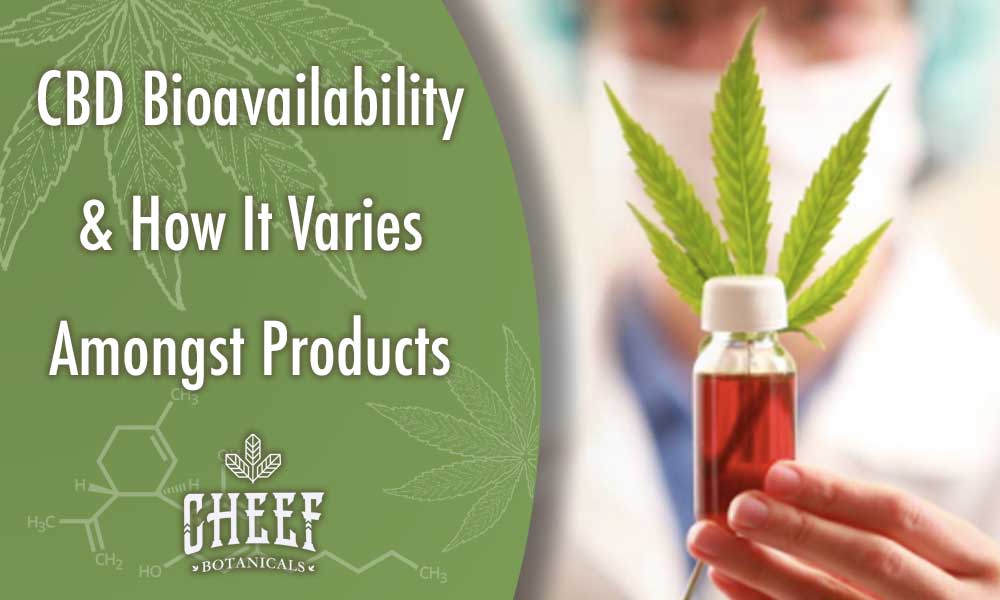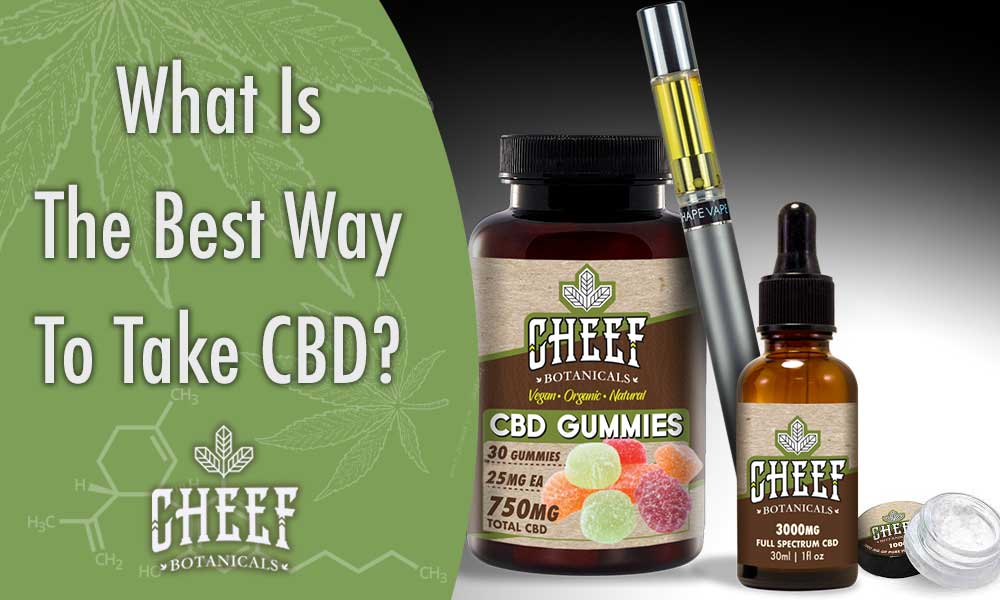CBD Bioavailability & Why It Should Matter to You
When we consider taking CBD, one of the most important things we think about is how effective it will actually be. As we know CBD offers many incredible benefits. So, how can we get the most out of it? This has much to do with its bioavailability, which is the amount of CBD that is actually active in the body. You see, not all the CBD in the product you take actually makes it into your system. There are many different factors which can affect the bioavailability of CBD.
What is CBD and How Does It Work?
Cannabis has been used for therapeutic purposes for thousands of years throughout the world. However, in western medicine, cannabis has only been studied since the mid-1900s. This is when researchers first began to discover the many potential benefits of CBD and how it works within the human body. CBD is short for cannabidiol. It is one of many naturally occurring cannabinoids found in cannabis. For legal purposes, cannabis is split into two categories. One category is hemp. Cheef Botanicals products use CBD that is extracted from hemp (grown in Colorado) and is legal within all of the United States. This is because hemp is NOT psychoactive and can only have a THC amount of 0.3% or under. The other category is marijuana, which is illegal in many states. If the THC level is over 0.3% the plant falls under the category of marijuana. CBD from marijuana is illegal in much of the U.S. Marijuana can get you high and hemp will not. This is the hugest difference between hemp and marijuana. Although, people selectively breed both to yield high amounts of CBD. Today, there is a growing body of evidence supporting the therapeutic value of CBD. 
CBD & The Human Endocannabinoid System
The reason CBD is of such great value to us is that it interacts very well with our bodies, thanks to our endocannabinoid system (ECS). That’s right, our bodies have a natural system dedicated to interacting with cannabinoids, such as cannabidiol. The endocannabinoid system is comprised of CB1 and CB2 receptors distributed throughout our body. CB1 receptors mainly reside in our brain and nervous system, as well as in our lungs, kidneys, eyes, skin, teeth, liver, and bowels. CB2 receptors, on the other hand, are located mostly in our immune system, including the spleen, stomach, and heart. Incredible changes in the body occur when cannabinoids interact with these receptors. The reason we all have an ECS is that our bodies naturally produce endocannabinoids. This cellular production of endocannabinoids is also a part of the ECS. The word "endo" means from within, meaning these cannabinoids produce naturally from within the human body. Cannabinoids made from plants such as hemp are phytocannabinoids. the word "phyto" means from a plant. There is a beautiful relationship between phytocannabinoids, endocannabinoids, and our endocannabinoid system. They are capable of working together in unison with one another. If your body's natural endocannabinoid level is low you can use cannabinoids like CBD to interact with the ECS just like your own endocannabinoids. CBD is capable of interacting with the ECS in many ways including:
The ECS regulates brain cell activity:
Epilepsy causes an individual to have unexpected and uncontrollable seizures due to abnormal hyperactivity of neurons in the brain. The endocannabinoid system acts on these overstimulated neurons and signals to other neurons to reduce their activity. The result is more control of brain activity and fewer seizures in an epileptic patient.
The ECS regulates inflammation:
Inflammation is our body’s natural response to infection or physical harm. Without inflammation, it is impossible for wounds and infections to heal. However, too much inflammation ends up doing the body more harm than good. We know inflammation usually equals pain, so generally the more severe the inflammation, the more painful it is. The ECS acts to suppress some of this inflammation, which helps to alleviate excessive pain and irritation.
CBD promotes homeostasis:
Homeostasis is our body’s natural tendency to maintain constant, stable conditions. It is a tendency toward equilibrium. Too much of anything can be bad, just like too much inflammation is harmful, and too much neuronal activity in the brain can cause problems. By increasing the functionality of the ECS, cannabinoids like CBD help the body achieve more stable conditions, which in turn optimizes our bodily functions.
What is CBD Bioavailability?
Bioavailability is, in short, the amount of a chemical compound that actually has an effect in proportion to the total amount that enters the body. That being said, CBD has varying bioavailability depending on a number of factors, the most notable being the method in which you consume it. But we’ll get back to that in just a bit. To understand CBD bioavailability, we first need to understand how CBD gets broken down by the body. CBD breaks down by a class of liver enzymes known as cytochrome P450. When CBD enters the body, it eventually reaches the liver where it binds to P450. Once bound, the CBD metabolizes, and at this point, its effects essentially begin to wear off. What determines the bioavailability is how much of the CBD is able to remain in the bloodstream. This can vary depending on how the CBD enters the body. Upon introduction into the body, CBD goes through a "first-pass metabolism" where some of it may breakdown on its way to the CB1 and CB2 receptors. Therefore, the route of administration plays a big role in determining how much CBD reaches its sites of action, and it is ultimately based on the type of product used.
Do All CBD Products Have the Same Bioavailability?
As previously mentioned, CBD bioavailability depends heavily on the method in which you consume it. The three main methods include:
- Oral consumption
- Sublingual consumption
- Vaporized consumption
Oral Consumption
CBD can be taken orally in the form of edibles or capsules. Oral consumption is the most complex method of consumption and requires the most time for the CBD to have an effect. This is because the capsule must enter the stomach first before its contents are absorbed into the blood, so in that process, some of it may get filtered out. In addition, the CBD is likely to pass through the liver and get broken down before reaching its sites of action, since it is so close to the stomach. These processes drastically reduce the bioavailability of CBD. Oral consumption of CBD usually has a bioavailability of 4-20%. This means that for every 100 milligrams of CBD you consume, only about four to twenty milligrams will be active in the body. Although CBD capsules and edibles have a lower level of bioavailability they do offer the user some advantages over other applications. Some people prefer capsules because they are discreet. You can easily throw them in a vitamin case, purse, or pocketbook. Some people prefer swallowing a capsule rather than tasting an oil (CBD tincture) or vaping CBD. Others prefer CBD edibles because of their indiscreetness and they make a tasty treat too.
Related Product: Try Our CBD Capsules

Sublingual Consumption
CBD can be taken sublingually in the form of oil tinctures. In this way, CBD absorbs through the sublingual gland into a system of capillaries leading to blood circulation. Sublingual administration of CBD is more efficient than oral consumption because it enters the bloodstream relatively quickly and is only degraded by salivary enzymes while in the mouth. Being a fairly direct administration of CBD, sublingual consumption has a bioavailability of about 12-35%.
Vaporized Consumption
CBD can be inhaled in the form of vapor. This is the most direct way of taking CBD out of the three methods we mention and takes action quite fast. When someone inhales CBD vapors, it absorbs straight into the bloodstream from the thin-walled alveoli of the lungs. This is very efficient because there is not much CBD degradation taking place. In fact, vaporized CBD has a bioavailability of up to 50% according to several studies. In relation to the other types of CBD products, vaping offers a lot of bioavailability.
Can You Increase the Bioavailability of CBD?
There isn’t much you can do to increase the bioavailability rate of CBD, other than to intravenously administer it or take a suppository, but these methods of application seem uncomfortable and excessive for most people. However, there are a couple of tips to help increase the CBD's effectiveness. One way is to simply use products that absorb quickest, such as CBD oil tinctures or CBD vaporizers. You can get a lot out of these products because there is little CBD that degrades along the way. Although, one thing to take into account is that some CBD goes to waste upon exhaling. Another way is to take CBD with fat-soluble foods such as fish, avocado, and nuts. This greatly enhances its bioavailability because it attaches to these fats and absorbs into the body as energy reserves, without degrading in the first pass. Studies show that using this technique increased CBD bioavailability by four times. The final key factor in increasing bioavailability is to use the highest quality CBD. Hemp plants contain a high CBD to THC ratio, providing a great source of the medicinal compound we know so much about. When extracted correctly with efficient methods like CO2 extraction, CBD bioavailability can be maximized.
What is the Best CBD Product for Bioavailability?
The best products are either vaporizers or oil tinctures, simply because they absorb the quickest. These products will ensure the highest possible bioavailability because they do not spend time in the digestive system and avoid breaking down along the way to the bloodstream. Rather, they enter through the lungs, where efficient gas exchange is occurring every second as you breathe, or through the venous capillaries surrounding the sublingual gland, respectively. In either case, you will certainly reap the many benefits of CBD. View more at Cheef Botanicals.
References
https://www.projectcbd.org/cbd-101/what-is-cbd https://medium.com/cbd-origin/what-is-cbd-bioavailability-and-why-does-it-matter-69d9a2e37e6c https://www.leafly.com/news/cannabis-101/whats-the-deal-with-these-high-cbd-strains https://www.leafly.com/news/science-tech/what-is-the-endocannabinoid-system https://www.mayoclinic.org/diseases-conditions/epilepsy/symptoms-causes/syc-20350093 https://www.medicalnewstoday.com/articles/248423.php http://howmed.net/pharmacology/bioavailability-of-drugs/ https://www.cannahealth.org/cbd-bioavailability-whats-the-best-way-to-absorb-cbd/ https://echoconnection.org/using-bioavailability-to-get-the-most-out-of-your-cbd/ https://echoconnection.org/are-all-cbd-oils-the-same/



 CBD Gummies - Top Seller
CBD Gummies - Top Seller
 CBD + THC Gummy - Excellent Choice
CBD + THC Gummy - Excellent Choice
 CBD Hemp Flower - Highly Rated
CBD Hemp Flower - Highly Rated
 Full Spectrum CBD Oil - Good Value
Full Spectrum CBD Oil - Good Value



Leave a comment
This site is protected by hCaptcha and the hCaptcha Privacy Policy and Terms of Service apply.